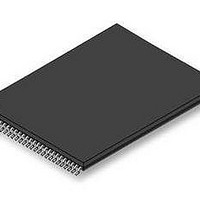S29GL256P11TFI010 Spansion Inc., S29GL256P11TFI010 Datasheet - Page 35

S29GL256P11TFI010
Manufacturer Part Number
S29GL256P11TFI010
Description
Flash 3V 256Mb Mirrorbit highest address110ns
Manufacturer
Spansion Inc.
Specifications of S29GL256P11TFI010
Memory Type
NOR
Memory Size
256 Mbit
Access Time
110 ns
Data Bus Width
8 bit, 16 bit
Architecture
Uniform
Interface Type
Page-mode
Supply Voltage (max)
3.6 V
Supply Voltage (min)
2.7 V
Maximum Operating Current
50 mA
Mounting Style
SMD/SMT
Operating Temperature
+ 85 C
Package / Case
TSOP-56
Memory Configuration
128K X 16
Ic Interface Type
Parallel
Supply Voltage Range
2.7V To 3.6V
Memory Case Style
TSOP
No. Of Pins
56
Lead Free Status / RoHS Status
Lead free / RoHS Compliant
Lead Free Status / RoHS Status
Lead free / RoHS Compliant, Lead free / RoHS Compliant
Available stocks
Company
Part Number
Manufacturer
Quantity
Price
Company:
Part Number:
S29GL256P11TFI010
Manufacturer:
SPANSION
Quantity:
5 530
Company:
Part Number:
S29GL256P11TFI010
Manufacturer:
SPANSION
Quantity:
72
November 21, 2006 S29GL-P_00_A3
7.8.2
7.8.3
7.8.4
DQ6: Toggle Bit I
DQ2: Toggle Bit II
Reading Toggle Bits DQ6/DQ2
Toggle Bit I on DQ6 indicates whether an Embedded Program or Erase algorithm is in progress or complete,
or whether the device has entered the Erase Suspend mode. Toggle Bit I may be read at any address, and is
valid after the rising edge of the final WE# pulse in the command sequence (prior to the program or erase
operation), and during the sector erase time-out.
During an Embedded Program or Erase algorithm operation, successive read cycles to any address cause
DQ6 to toggle. When the operation is complete, DQ6 stops toggling.
After an erase command sequence is written, if all sectors selected for erasing are protected, DQ6 toggles for
approximately 100
Embedded Erase algorithm erases the unprotected sectors, and ignores the selected sectors that are
protected.
The system can use DQ6 and DQ2 together to determine whether a sector is actively erasing or is erase-
suspended. When the device is actively erasing (that is, the Embedded Erase algorithm is in progress), DQ6
toggles. When the device enters the Erase Suspend mode, DQ6 stops toggling. However, the system must
also use DQ2 to determine which sectors are erasing or erase-suspended. Alternatively, the system can use
DQ7 (see the subsection on DQ7: Data# Polling).
If a program address falls within a protected sector, DQ6 toggles for approximately 1
command sequence is written, then returns to reading array data.
DQ6 also toggles during the erase-suspend-program mode, and stops toggling once the Embedded Program
Algorithm is complete.
See the following for additional information:
Toggle Bit I on DQ6 requires either OE# or CE# to be de-asserted and reasserted to show the change in
state.
The “Toggle Bit II” on DQ2, when used with DQ6, indicates whether a particular sector is actively erasing (that
is, the Embedded Erase algorithm is in progress), or whether that sector is erase-suspended. Toggle Bit II is
valid after the rising edge of the final WE# pulse in the command sequence. DQ2 toggles when the system
reads at addresses within those sectors that have been selected for erasure. But DQ2 cannot distinguish
whether the sector is actively erasing or is erase-suspended. DQ6, by comparison, indicates whether the
device is actively erasing, or is in Erase Suspend, but cannot distinguish which sectors are selected for
erasure. Thus, both status bits are required for sector and mode information. Refer to
outputs for DQ2 and DQ6. See
Whenever the system initially begins reading toggle bit status, it must read DQ7–DQ0 at least twice in a row
to determine whether a toggle bit is toggling. Typically, the system would note and store the value of the
toggle bit after the first read. After the second read, the system would compare the new value of the toggle bit
with the first. If the toggle bit is not toggling, the device has completed the program or erases operation. The
system can read array data on DQ7–DQ0 on the following read cycle. However, if after the initial two read
cycles, the system determines that the toggle bit is still toggling, the system also should note whether the
value of DQ5 is high (see the section on DQ5). If it is, the system should then determine again whether the
toggle bit is toggling, since the toggle bit may have stopped toggling just as DQ5 went high. If the toggle bit is
no longer toggling, the device has successfully completed the program or erases operation. If it is still
toggling, the device did not complete the operation successfully, and the system must write the reset
command to return to reading array data. The remaining scenario is that the system initially determines that
the toggle bit is toggling and DQ5 has not gone high. The system may continue to monitor the toggle bit and
DQ5 through successive read cycles, determining the status as described in the previous paragraph.
Alternatively, it may choose to perform other system tasks. In this case, the system must start at the
beginning of the algorithm when it returns to determine the status of the operation. Refer to
more details.
Note
When verifying the status of a write operation (embedded program/erase) of a memory sector, DQ6 and DQ2
toggle between high and low states in a series of consecutive and con-tiguous status read cycles. In order for
D a t a
S h e e t
μ
s, then returns to reading array data. If not all selected sectors are protected, the
( A d v a n c e
S29GL-P MirrorBit
Figure 11.14 on page 57
Figure
I n f o r m a t i o n )
TM
Flash Family
7.4,
Figure 11.13 on page
for additional information.
57, and
μ
Table 7.17
s after the program
Table
Figure 7.4
7.17.
to compare
for
33

















